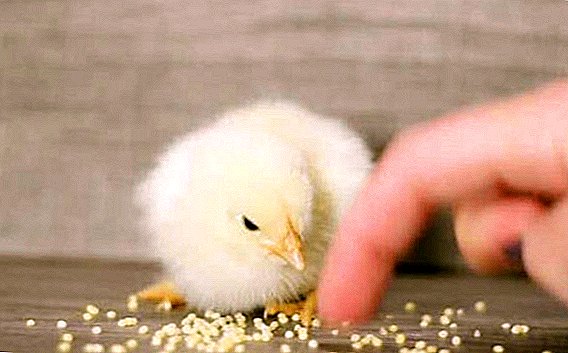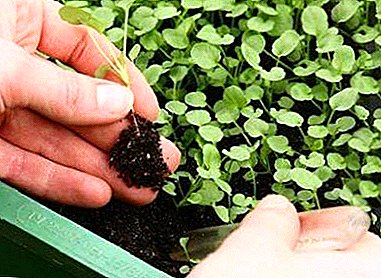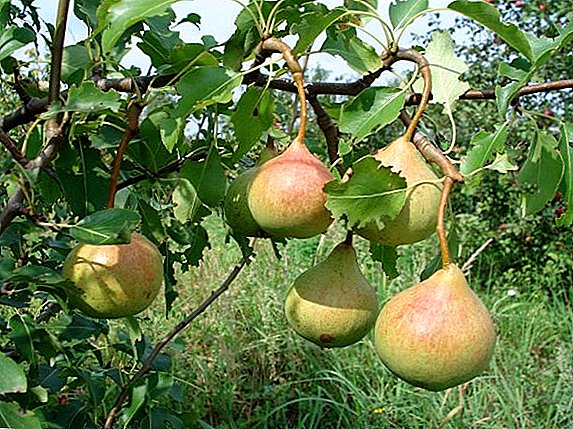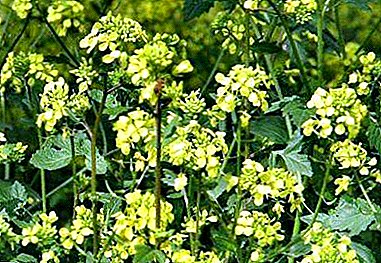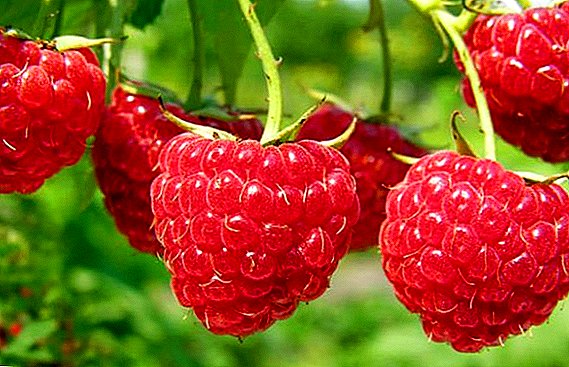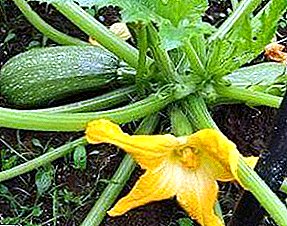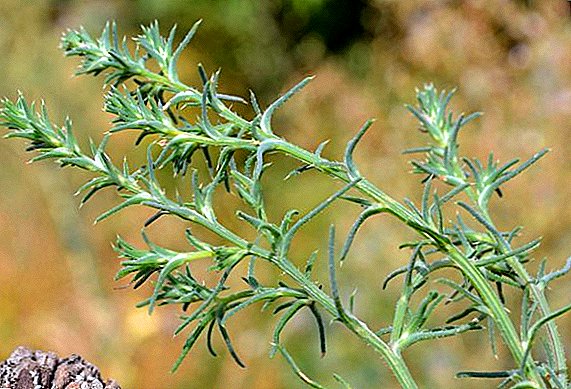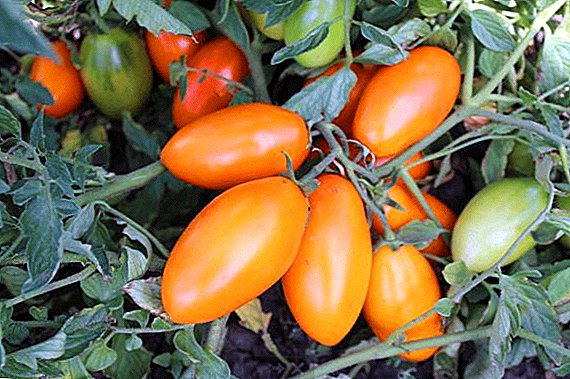 There are various varieties of garden crops, which quickly become popular among gardeners, stay in this status for several years, and then they are safely forgotten. And there are varieties that are in the "trend" for many decades. There are not so many exceptionally successful developments of breeders. Tomato "Golden Stream" - one of them.
There are various varieties of garden crops, which quickly become popular among gardeners, stay in this status for several years, and then they are safely forgotten. And there are varieties that are in the "trend" for many decades. There are not so many exceptionally successful developments of breeders. Tomato "Golden Stream" - one of them.
Variety description
The hybrid "Golden Stream" was bred by Kharkov breeders at the Institute of Vegetable and Melon-Growing. At first, the variety gained popularity in Moldova and Ukraine, and after a while it became known in Russia, where for almost a decade and a half it surely holds in the lead among the preferences of gardeners.
"Golden Stream" - super-early variety. 3 months after sowing seeds, you can already make a salad of fresh tomatoes. In addition to the beautiful, memorable appearance, the fruits have an excellent taste, grow compactly and ripen at about the same time.
Learn about the timing of garden events for tomatoes on the lunar calendar.
Refers to determinant varieties. The bush will melt before the appearance of 5-7 brushes, by this time it reaches a height of no more than 0.7 m. After that, the plant ceases to spend energy and useful substances to set its own green mass, and switches completely to the formation and development of fruits.

Tomatoes are suitable for use raw, preserved whole, for preparing juices and fruit drinks. The variety carries storage and transportation quite easily.
With proper care, it is possible to collect from 1 square. m to 10 kg of tomatoes. Up to 35 tons of crop can be harvested from 1 ha.
Among the advantages of the "Golden Stream" are the following:
- good yields;
- resistance to diseases and pests;
- easily transfers storage and transportation;
- adapted to different weather conditions;
- fruits grow about the same size;
- suitable for various uses (raw and preserved).
Did you know? Botany considers tomatoes berry. At the end of the 19th century, the US Supreme Court issued a verdict according to which a tomato is a vegetable. At the very beginning of the XXI century, the EU called it a fruit. If we start from the EU’s position on this issue and consider a tomato a fruit, then it should be said that this fruit ranks first in the world in terms of cultivation. World production of tomatoes by 30% exceeds the volume of all bananas grown on the planet, which occupy the second place.
Fruit characteristics and yield
Tomatoes of medium size grow 6-9 pieces on one brush. They have an elongated plum-shaped form, a beautiful amber-yellow color, almost imperceptible chambers (4-6 pieces) with a small number of seeds. Fruit weight - 65-80 g.

The flesh is thick and sweet, with a high content of carotene and a large, as for tomatoes, sugar content - more than 4%.
As mentioned above, the plant begins to bear fruit about 13 weeks after sowing the seeds. Depending on the latitude of your region, air temperature and the time of sowing seeds, you can get the first crop of tomatoes at the end of June.
The variety is undersized, also undersized varieties of tomatoes: "Dwarf", "Raspberry Giant", "Klusha", "Chocolate", "Rio Fuego", "Riddle", "Stolypin", "Sanka", "Apparently Invisible", "Lazyka "," Bobkat "," Liana "," Newbie "," Balcony miracle "," Chio-Chio-San ".
Selection of seedlings
If you want to get a good harvest of tomatoes, it is very important to choose the appropriate seedlings. In that case, if the seedlings were initially not of the best quality, you can, of course, save it, but it will take a lot of time and effort for both your plants and you.
And, conversely, good quality seedlings will forgive you some omissions in care and without consequences will endure minor mistakes in growing.

It is best to purchase seedlings from a proven gardener who specializes in this variety. But not all novice gardeners have such acquaintances, so you have to go to the market.
Important! Do not buy seedlings with ovaries. If this happens, they should be removed upon arrival.Consider that buying seedlings on the market is always a lottery. Not the fact that you are lucky, and you will be taken to a bona fide manufacturer. Therefore, to start, talk with the seller of planting material, ask him about the characteristics of the variety, its characteristics.
Any gardener, enthusiastic about his business, who grows seedlings not so much for earnings as “out of love for art”, will give you a lot of information about favorite tomatoes. Very often, such an enthusiastic person is difficult to stop, but with almost one hundred percent probability it can be argued that you have come to the right place.

Now you can proceed to inspect the external data of seedlings:
- The best age for planting seedlings "Golden Stream" in the ground is 8-9 weeks. Taking into account the time you need for the final preparation of the beds, you need to buy planting material at the age of 50-55 days.
- The ideal seedling should look something like this: height - 26-30 cm, the number of leaves - from 7 to 10.
- The thickness of the stem should be from 0.6 to 0.8 mm, uniform green color, without any signs of dryness.
- Carefully inspect the root system for breakage and dry areas. It is imperative that the roots are in a moist earthy coma.
- The foliage must be of the correct characteristic shape, without deformations and hanging leaves.
- If you paid attention to the excessively bright color of the leaves, while they still hung on weak petioles, most likely, when growing in large quantities used growth stimulants. It is better not to buy such seedlings.
Did you know? Argued that the most useful substances found in fresh raw vegetables. With regard to tomatoes, this statement is only partly true. The fact is that lycopene (an antioxidant contained in tomatoes) when heated is released from the cell membrane and is much better absorbed by the body.
Growing conditions
For growing tomatoes suitable sandy soil with a neutral pH (6.0-7.0). Tomatoes feel good in areas where carrots, onions and beets have grown. It is quite acceptable to plant the crop after radish and cucumber. But after the legumes, pumpkin (except cucumber) and their counterparts - tomatoes, it is better not to plant the crop, because the land has already given all the nutrients to its predecessors.

To prepare the ground for tomatoes need to fall. Future beds need to dig, remove weeds and fertilize (per 1 sq. M):
- humus - 6 kg;
- superphosphate - 50 g
- litter (chicken or pigeon) - 1 kg;
- sifted wood ash - 1 kg;
- ammonium sulfate - 25 g
Learn how to determine the acidity of the soil, how to fertilize the soil, how to prepare the soil for tomato seedlings, how to disinfect the earth.
A few words about growing conditions under which plants are most productive:
- Do not plant tomatoes in the ground until it warms up to at least +14 ° C. At the same time, the daily air temperature should rise to +24 ° С and higher, and at night it should not fall below +15 ° С.
- Tomatoes require regular, abundant watering (2 times a week with moderate rainfall).
- Root cooling should not be allowed; in case of a cold snap, cover the areas around the root with mulch.
- The beds should be sheltered from drafts and direct sunlight, but at the same time, the plants need enough light.
Seed preparation and planting
Approximately 2 months before planting a young seedling in an open ground, seeds are planted on seedlings.

The timing can be determined more precisely as follows: it is necessary to find out when the air temperature in your region is set at the above level (during the day - +24 ° C and above, at night - not below + 15 ° C), and the soil warms up no less than +14 ° C. Subtract 2 months from this date - this will be the estimated time for sowing seeds for seedlings.
Before planting, the seeds must be pretreated. If you have purchased planting material from a reputable manufacturer, then you only need to germinate the seeds, they have already passed the rest of the preliminary processing (disinfection and hardening).
Important! Before sowing, the seeds must be dried well. If this is not done, they will rot in the damp earth.If the seeds were purchased on the market or your own billet, they must be processed.

To begin, disinfection should be carried out:
- For this purpose, apply 1% solution of potassium permanganate. Planting material is put into the solution for 15-25 minutes, then washed with clean water.
- Suitable and 0.5% solution of sodium bicarbonate. Such a procedure not only disinfects, but also has a positive effect on seed germination (keep in solution for 20-22 hours).
- The drug "Fitosporin-M" is another remedy that has worked well for seed treatment. Use it according to the instructions.
Learn more about preplant treatment of tomato seeds.
The next stage is to prepare the ground for seedlings. You can purchase ready-made mixes in the store, or you can prepare the substrate yourself:
- Mix in equal parts turf, peat and sand, the mixture should be shed with this solution: superphosphate - 20 g, potassium sulphate - 10 g, urea - 10 g (per 10 l of warm water);
- or take 1/3 part of humus, peat and turf, mix well, add 10 g of superphosphate and 2 cups of wood ash to 10 liters of substrate.
- Cover with a layer of 2-3 cm on a baking sheet and send to the oven for 20 minutes (t - + 190-210 ° C).
- Warm up for 3 minutes at maximum mode in the microwave oven.
- Dissolve in 10 liters of boiling water 1 tsp. with potassium permanganate slide, pour the prepared soil with the resulting solution (plastic 5-6 liter containers with holes made in the bottom can be used to drain the liquid).
How to disinfect the soil for seedlings: video
After the seeds and soil are ready, you can start planting. A container prepared for seedlings (boxes, plastic containers, etc.) is filled with a substrate a week before sowing seeds. The soil needs a few days to properly lie down. By the time of sowing the soil should be slightly moistened.
On the soil surface, make grooves with a depth of 10-15 mm. In them at a distance of 2-2.5 cm from each other, lay the seeds, sprinkle the top with the substrate.
Seed containers cover the film, it will create the desired microclimate. The minimum air temperature at which the seedlings should grow is +24 ° С. Open the foil daily for 5-7 minutes to ensure air flow. After the appearance of the first shoots, the film cover is completely removed.
Did you know? Tomatoes are great for eating diabetic patients. They contain a lot of chromium, necessary to maintain a stable blood sugar level.
Tomato sowing: video
Maintenance and care
Seedlings are particularly sensitive to soil moisture. Ensure that the earth does not dry out. If the surface of the soil is dry - use the broom.
However, it is also not possible to flood the shoots. In this case, it is necessary to place the seedlings in a place with a high temperature (near the fitolamps or batteries) for the quick drying of the soil. After the third leaf appears, the shoots need to be dive - leave the strongest ones, thinning the rest.
Do not allow drafts. Pay particular attention to this point if the seating tanks are on the windowsill.
Learn more about how to choose the optimal time for sowing tomatoes, how to care for tomato seedlings, how to pick the tomatoes correctly, how to feed tomato seedlings when planting tomatoes in open ground.
Shoots need hardening. When there will be sunny windless weather, open the window for 6-8 minutes, you can take out the plants on the balcony or the street. It is necessary to repeat the procedure regularly, but it should be remembered that drafts to seedlings are categorically contraindicated.
When your seedlings reach the above conditions (height - 26-30 cm, about 10 leaves), it should be planted in the ground. Soil and beds by this time should already be prepared. If it's still cool outside, you can use a garden film to create a cover.
 Before planting, be sure to harden in the sun, constantly increasing the time of stay, otherwise the seedlings will get sunburn and will not recover
Before planting, be sure to harden in the sun, constantly increasing the time of stay, otherwise the seedlings will get sunburn and will not recover
And you can slow down the growth of seedlings, reducing its watering and air temperature to a minimum. The procedure is harmless, just the metabolic processes in the plant for a while slow down.
The bed should be arranged this way.:
- Shrubs arranged in staggered order. The distance between the bushes in the same row - 0.3 m, the distance between adjacent rows (within the same beds) - 0.4 m.
- At the designated points for 2-3 days before planting, dig holes in such a way that they fit a bush with a clod of earth. The wells must be shed with boiling water with potassium permanganate (1 tsp. Per 10 liters of water). Then shed normal warm water and cover with garden film.
Check out the tomato planting scheme.
When the time comes to plant the seedlings in the beds, carefully, so as not to damage the roots, remove the seedlings from the boxes.
- In the prepared hole you need to carefully install the seedling, so that the root neck is just above ground level.
- Roots when planting should not be placed deep, the ground at a depth may not have warmed up.
- Sapling must be sprinkled with soil, lightly tamping the ground with his hands.
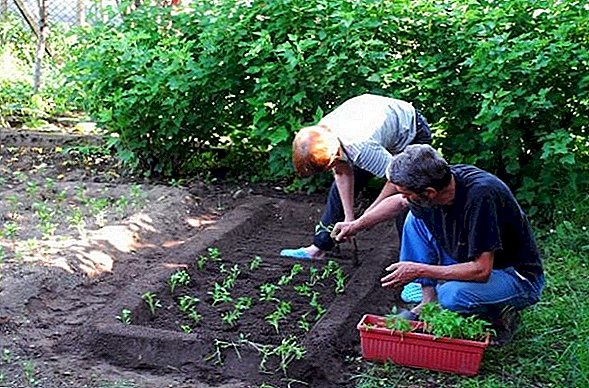 Tomato seedlings should be planted in the absence of the threat of frost.
Tomato seedlings should be planted in the absence of the threat of frost.
The essential advantages of a variety can be considered its small height, which allows it not to resort to a hatching, and its compact structure, due to which the bush does not require formation. As soon as the bush reaches its optimal size, it will stop growing high without burdening you with unnecessary trouble.
Although the bush is not very big growth, the garter will not be superfluous. It is possible to install tapestries, and it is possible to build an individual stand near each bush. Garter is needed, first of all, in order to make it easier for the plant to withstand the severity of the fruit during a bountiful harvest.
Important! Passing is necessary only in conditions of growing tomatoes in regions with sudden, sudden changes in weather conditions.Every 3 days it is necessary to water the tomatoes with a watering can with warm water, after which it is necessary to break through the soil so that it does not become covered with a crust. Together with the loosening should weed the beds.
 Tomatoes should be watered at the root, in order to avoid disease, follow that the moisture does not linger on the sheets
Tomatoes should be watered at the root, in order to avoid disease, follow that the moisture does not linger on the sheets
In the first 3 weeks, the depth of soil loosening is about 10 cm. Then it is necessary to reduce the depth to 5-7 cm, as the roots develop, and excessive soil intrusion can harm them.
After 3 weeks after landing in the ground, when the plant will already feel confident in the new place, after loosening the ground, you can pile up the bush. This procedure will create the right climate for the roots and contribute to their active growth.
For normal growth and fruiting, the tomato is fed 3 times. The first time - 15 days after landing in the ground. In the period of formation of the ovaries make a second feeding. As soon as the fruits begin to ripen, fertilizers are applied for a third time.
Learn how to feed tomatoes during fruiting.
For the first feeding, ammonium nitrate can be used (30 g per 20 l of water). The need of one plant is about 0.5 l of solution.
For the second time, feeding with superphosphate (15 g) and potassium chloride (7 g) is suitable. To apply fertilizer, it is necessary to make longitudinal trenches 5 cm deep along the beds, 25 cm from the tomato bushes. They should evenly distribute the fertilizers, and sprinkle them on the top with moist earth.
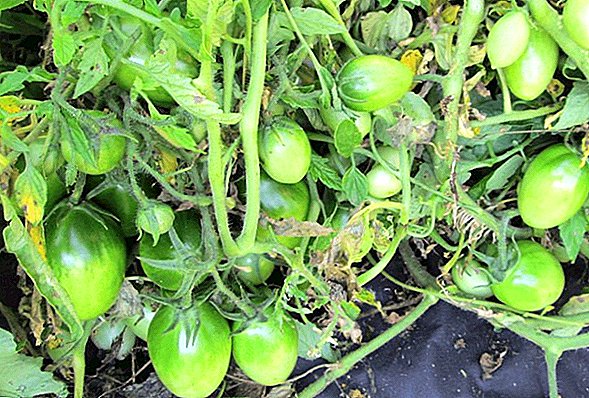
The third time make ammonium nitrate, in the same dosage as the first time.
Good for feeding and mullein, but it must be rotted, otherwise its presence will affect the taste of tomatoes. Dissolve 5 kg of manure in 25 liters of water, let it brew for 2 weeks. Mix the resulting product with water (1:20) - water the plants with this solution (1 l per bush).
After disembarking, tomatoes are fed with nitrogen, potassium and magnesium. In the period when the fruits begin to form, you can make ammonium nitrate.
Did you know? One large tomato contains about 2/3 of the daily human need for ascorbic acid.
Disease and pest prevention
Unfortunately, tomatoes are attacked by all sorts of pests and some diseases. 
- Colorado beetle. The parasite is extremely dangerous for plants, destroys foliage and ovary. To combat the pest, there are many different insecticidal agents ("Bankol", "Bombardier", "Typhoon", etc.) that must be used according to the instructions. From folk remedies can be called such: spraying infusion of ash and wormwood, tincture of adult Colorado beetles, pollination of birch plant ashes during flowering.
- Medvedka. A dangerous parasite - a lover of tomatoes. It lives in moist manure soils. The threat to plants comes from the larvae, and from adult insects. Parasites dig holes, gnaw the roots of tomatoes, causing them irreparable harm. Для уничтожения применяют "Конфидор", "Боверин", "Медветокс" согласно инструкции.From agrotechnical means it is necessary to distinguish such: regularly loosen between bushes and beds (thus you destroy the egg-laying of insects), avoid using manure. You can plant marigolds around bushes - pests try not to approach them.
- Wireworm. Another pest that affects the root and stalks of tomatoes. In the fight against it is quite effective "Basudin". The drug is mixed with sand, fall asleep in shallow grooves near the bush and sprinkled with earth.
- Scoop on tomatoes. The caterpillar first eats the tops of the plants, and then goes to the ovary. Very afraid of spraying garlic infusion.

The most common diseases affecting tomatoes include phyllossticosis, white spot, black leg.
- White spotting. A characteristic sign - rusty spots on the foliage, which soon showered. Treat the diseased plant by spraying with a 1% solution of Bordeaux mixture (10 g per 10 l of water). Since the pathogen lives on infected leaves, all last year’s leaves must be removed and burned.
- Blackleg. Dangerous fungal disease. Before planting, the soil should be treated with colloidal sulfur (0.005 g per 1 sq. M) and a solution of potassium permanganate (1 tsp. Per bucket of water).
- Phyllosticosis Manifested on the leaves at the bottom of the bush. The top of the sheet is rust-colored, on the other side is a green-yellow shade. Leaves wither and fall off. If tomatoes grow in the greenhouse, it is necessary to lower the air humidity to 55-58%. Recommended spraying of copper sulphate (100 g per 10 liters of water).
Important! "Golden flow" is very resistant to diseases. Due to his very early maturity, he simply does not have time to become infected with some of the diseases, for example, late blight.
Harvesting and storage
At the end of June - the beginning of June, you can enjoy the wonderful golden-amber fruits. Ultra early varieties begin to bear fruit almost immediately, at the same time. They are not typical of gradual ripening, when on one bush there are fruits of different degrees of maturity - from completely green to ripe.

If you want to prolong the fruiting time, tomatoes should be harvested unripe, in the so-called technical degree of maturity. The fruits collected at this stage will reach and will not differ in any way from the collected ones completely ripe.
But, after harvesting with greens, you will free up plant resources. Instead of spending power on the ripening of the tomato (which is completely well fully ripe and independently), the bush will direct them to the formation of new ovaries.
Tomatoes can be prepared adjika, tomato juice, pickled, pickled tomatoes, salads, tomatoes in jelly.
In late summer, with a decrease in temperature, the plants slow down their metabolic processes, and soon die altogether. At this time it is necessary to collect all the remaining crop, otherwise the fruits on the bushes will spoil.
All tomatoes are extremely sensitive to cold. In that case, if the night temperature regularly drops to + 5 ° C, and the plant still has fruits, they no longer mature.

If frost is "on the nose" and there are still fruits on the bushes, you can proceed as follows:
- Plants are dug out of the garden as a whole, along with the root system.
- Shrubs with fruits are stacked in pile with a height of 0.7-0.9 m, all roots should be directed in one direction.
- The resulting heaps are covered with straw and left. After 10-12 days, some of the tomatoes will ripen, it must be removed from the bush, at the same time to remove rotted or damaged.
Did you know? As part of tomatoes, more than 90% is water. If you really want to throw a few extra pounds, this fruit is indispensable for you. It is rich in fiber, which has a beneficial effect on the digestive tract, and potassium, which helps remove excess fluid and toxins from the body.You can leave the tomatoes on the floor of the greenhouse, laying a garden film under them, and covering them with hay on top. The recommended temperature is + 16-23 ° C. Humidity of air - 70-80%. The glazing of the greenhouse must be whitened with lime so that the hot sun does not burn the tomatoes.

Beautiful, original and absolutely unpretentious in the care of tomatoes, no wonder so quickly gained popularity. Gardeners claim that the “Golden Stream” will be able to grow even a beginner amateur. And if you add to these characteristics excellent taste, super early ripeness, disease resistance and versatility of the variety, all doubts disappear - you just need to grow this amber miracle in your garden.
Grade Reviews



